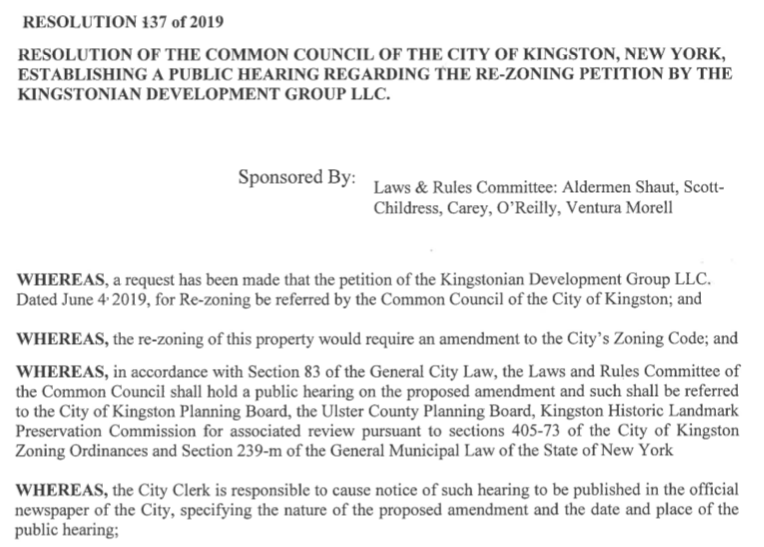By Rebecca Martin
As the community waits for the Planning Board to issue a positive or negative declaration in the State Environmental Quality Review (SEQR) for the Kingstonian project, it has come to light that a portion of the Kingstonian site is located outside of the Mixed-Use Overlay District (MUOD) in Uptown Kingston and therefore requires an additional approval by the Kingston Common Council.
What is the Mixed Use Overlay in the Stockade District?
“The Mixed Use Overlay District (MUOD) was adopted in 2005 as an amendment to the City’s Zoning Code following three years of debate. (See “Kingston council OKs Uptown/Midtown loft law,” Daily Freeman, 5 January 2005. ) Its primary purpose was to ease the regulatory burden of converting upper floors in existing commercial buildings to residential use. Instead of applying for a variance from the Zoning Board of Appeals, building owners could apply for a less onerous Special Use Permit from the Planning Board.
There are two MUODs in the city: the Stockade and Midtown. The thinking of council members at the time was that by making the adaptive reuse of commercial buildings in these districts easier, it would incentivize the creation of affordable housing units. Much of the text of the amendment (which was created with assistance by Greenplan, a planning consultant out of Rhinebeck) focuses on affordable housing, which is intended to be based on guidelines outlined therein. It is intended to apply to adaptive reuse projects containing five or more residential units wherein 20% of those units must be maintained as affordable (defined as 80% of the Ulster County median income.) Such units are to be dispersed throughout the proposed housing project, be indistinguishable from market-rate units, and the affordable unit rents are not to exceed 30% of a household’s income.
But there are few (if any) buildings in the Stockade that could accommodate five units or more. An analysis of these properties is likely to show that no affordable units have been created in the Stockade District with this regulation. (See “Upstairs Apartments Fail to Materialize in Stockade, Midtown Kingston,” Daily Freeman, 11 February 2007.)
In addition to promoting the creation of affordable housing, the MUOD text describes a second underlying purpose: “to encourage mixed-use, mixed-income, pedestrian-based neighborhoods” (§ 405-27.1, subparagraph B-2.) It seems that the Kingstonian project, which neither proposes to build any affordable housing units nor seeks to adaptively reuse any buildings, is narrowly interpreting this second clause as the basis for its qualifying for the more expeditious Special Use Permit application process. (In its Environmental Assessment Form, the applicant flags the MUOD as an applicable zoning measure.) To achieve this second purpose, the amendment allows “site and building enhancements that promote a mixed-use, mixed-income, pedestrian-based neighborhood” to qualify for a Special Use Permit. Apparently, “site enhancements” can be interpreted to mean new construction.

